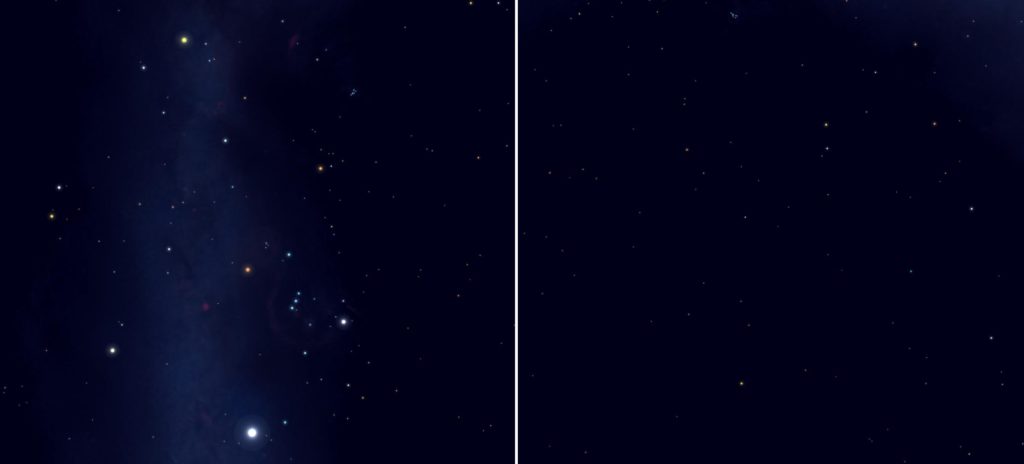Sky Report: January 17 – January 23

The sky centered on Orion (left) and on Cetus (right). Graphic created with SkySafariAstronomy.com.
Jupiter is the sole bright planet in the evening sky. It sets 4 minutes earlier each night and we’ll lose it next month. You might see Saturn one-half hour after sunset only a few degrees above the west-northwest horizon at the 5 o’clock position from Jupiter, with binoculars, but it won’t be easy.
That leaves us with the moon and a sky full of stars. The moon is full on Martin Luther King Day, and beginning a few days after that the evening sky is moonless and dark, at least until moonrise.
Few people can point out the huge constellations that fill the southern sky in the early evening – Aquarius, Cetus, Pisces, and Eridanus — because they lie out of the Milky Way and have few bright stars. In contrast, the constellations that rise next – Orion, the two Hunting Dogs, Taurus, and Gemini, lie in the Milky Way, have many bright stars, and are easy to pick out. There are more bright stars in the east as darkness falls than in any equivalent area of the sky because there we’re looking into, instead of out of, the plane of the Milky Way, and toward the closest spiral arm. The contrast between the southern and eastern sky is striking; it tells us where we are within our own galaxy. The Milky Way itself arcs from the northeast to nearly overhead to the southeast.
If you have a telescope, four relatively bright comets brighter than 9th magnitude are in the evening sky – and it’s highly unusual to be able to see four comets at once. Comet Borrelly remains around 8th magnitude in Cetus. It’s leaving the earth and sun behind so it’s very slowly fading. Other comets are 104P Kowal in Pisces, C/2019 L3 Atlas in Gemini, and 67P/Churyumov-Gerasimenko in Cancer. Finding charts are at heavens-above.com; customize for your location.
Also with your telescope check out Near Earth Asteroid 7482 which is whizzing past earth, safely missing us, and visible through a telescope that will reach 10th magnitude on the 17th, 18th, and 19th only. On those three nights it will move so fast you can actually watch it move against the stellar background and this is highly unusual; I’ve watched an asteroid move only twice. Google it or use an electronic star chart like SkySafari. (I don’t get a commission for plugging SkySafari; it’s the app I use.)
Thanks to a 2021 grant from the Utah Governor’s Office of Economic Development and the Kane County Office of Tourism, Stellar Vista Observatory offers portable telescopes and tripod mounted binocular kits on loan for free to all residents of Kane County. Nothing beats a quality binocular or astronomical telescope to enhance enjoyment of the night sky! Visit https://stellarvistaobservatory.org/discover-the-night-sky/ or Kanab City Library for full details.
The Sky Report is presented as a public service by the Stellar Vista Observatory, a nonprofit organization based in Kanab, Utah, which provides opportunities for people to observe, appreciate, and comprehend our starry night sky. Additional information is at www.stellarvistaobservatory.org. Send questions and comments to John@StargazingAdventures.org.






Comments are closed.